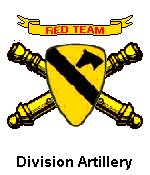
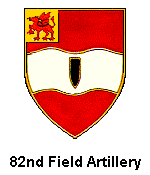
82nd Field Artillery
Organizational Legacy
"Can and Will"


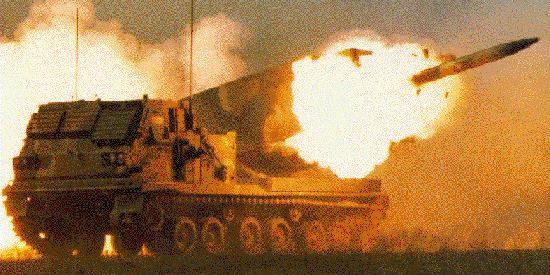 |
|---|
| M-270 Multiple Launch Rocket System (MLRS) |
|---|

Regimental Distinctive Unit Insignia
 Introduction
Introduction


 The 1st Cavalry Division, a major subordinate command of the US Third Mobile
Armored Corps, is a 19,000 soldier, heavy armored division stationed at Ft.
Hood, TX. As one of the two "on-call" heavy contingency force divisions of the
Army, the First Team has an on-order mission to deploy by sea, air or land to
any part of the world on a short notice. The following narratives, divided in
timeline eras of major operational missions, describes the threat environment,
tactical conditions, evolution of equipment technology and the strategic
methodology employed its manuever command units, the 1st, 2nd, 3rd and 4th
Brigade Combat Team and its Subordinate Units, to contribute to the highly
successful missions enhancement of the warring organization of the 1st Cavalry
Division and the honors they achieved are summarized in the chapters that
follow.
The 1st Cavalry Division, a major subordinate command of the US Third Mobile
Armored Corps, is a 19,000 soldier, heavy armored division stationed at Ft.
Hood, TX. As one of the two "on-call" heavy contingency force divisions of the
Army, the First Team has an on-order mission to deploy by sea, air or land to
any part of the world on a short notice. The following narratives, divided in
timeline eras of major operational missions, describes the threat environment,
tactical conditions, evolution of equipment technology and the strategic
methodology employed its manuever command units, the 1st, 2nd, 3rd and 4th
Brigade Combat Team and its Subordinate Units, to contribute to the highly
successful missions enhancement of the warring organization of the 1st Cavalry
Division and the honors they achieved are summarized in the chapters that
follow.
Mission:
 When directed, the 1st, 2nd, 3rd and 5th Battalions of tjhe 82nd Field
Artillery deploys to a designated contingency area of operations, conducts
Reception, Staging, Onward movement and Integration (RSO&I) and on order
plans, and coordinates for and synchronizes the use of all indirect fires in
support of combat operations.
When directed, the 1st, 2nd, 3rd and 5th Battalions of tjhe 82nd Field
Artillery deploys to a designated contingency area of operations, conducts
Reception, Staging, Onward movement and Integration (RSO&I) and on order
plans, and coordinates for and synchronizes the use of all indirect fires in
support of combat operations.
Organizational Summary:
 The United States Artillery can be traced back to the Military Company of
Massachusetts, which was chartered in 1638, and with other colonial artillery
companies formed what became the Continental Artillery. More than a century
later, in April 1775, the legislature authorized the formation of an artillery
regiment. This unit was first commanded by Colonel Richard Gridley, a former
British artillery officer who later was replaced by Colonel Henry Knox.
Colonel Knox eventually became the Chief of Artillery and is credited with
shaping artillery tactics for the remainder of the Revolution.
The United States Artillery can be traced back to the Military Company of
Massachusetts, which was chartered in 1638, and with other colonial artillery
companies formed what became the Continental Artillery. More than a century
later, in April 1775, the legislature authorized the formation of an artillery
regiment. This unit was first commanded by Colonel Richard Gridley, a former
British artillery officer who later was replaced by Colonel Henry Knox.
Colonel Knox eventually became the Chief of Artillery and is credited with
shaping artillery tactics for the remainder of the Revolution.
 The continued utilization of technical innovations throughout their history
has enabled the artillery to be a decisive threat to destroy, neutralize, or
suppress the enemy. Not since the formulation of gunpowder by the Chinese, two
technical innovations faced the artillerymen; rifling and breech loading. To
the forward looking military arsenal manufacturer, their utility was not in
doubt - but the engineering of a reliable design and integrating the geometry
of the ammunition into the cannon had many problems. You may be interested in
reading about the technical and contractual problems of one such early pioneer,
"The Free
Enterprise Patriot", who expended many years in building and testing a
prototype, but was unable to supply a timely design to the Colonial Army,
hence their introduction was delayed until the Civil War Period.
The continued utilization of technical innovations throughout their history
has enabled the artillery to be a decisive threat to destroy, neutralize, or
suppress the enemy. Not since the formulation of gunpowder by the Chinese, two
technical innovations faced the artillerymen; rifling and breech loading. To
the forward looking military arsenal manufacturer, their utility was not in
doubt - but the engineering of a reliable design and integrating the geometry
of the ammunition into the cannon had many problems. You may be interested in
reading about the technical and contractual problems of one such early pioneer,
"The Free
Enterprise Patriot", who expended many years in building and testing a
prototype, but was unable to supply a timely design to the Colonial Army,
hence their introduction was delayed until the Civil War Period.
 From the historical battlefields of Yorktown and Gettysburg, through the
Western Plains, Mexican and Spanish American Wars, the artillery was always
there. In fact, the nickname, "Redlegs", comes from that era when artillery
uniforms had a 2-inch red stripe on their trousers and horse artillery men
wore red canvas leggings. Continuing through the modern days of the European
and Asian Theaters of WWII, the Pusan Perimeter in Korea, the Ia Drang Valley
in Vietnam, to the "Steel Rain" of Desert Storm, "Redlegs" have served with
distinction and valor in all of our country's armed conflicts.
From the historical battlefields of Yorktown and Gettysburg, through the
Western Plains, Mexican and Spanish American Wars, the artillery was always
there. In fact, the nickname, "Redlegs", comes from that era when artillery
uniforms had a 2-inch red stripe on their trousers and horse artillery men
wore red canvas leggings. Continuing through the modern days of the European
and Asian Theaters of WWII, the Pusan Perimeter in Korea, the Ia Drang Valley
in Vietnam, to the "Steel Rain" of Desert Storm, "Redlegs" have served with
distinction and valor in all of our country's armed conflicts.
 The 82nd Field Artillery (Horse) Regiment traces its ancestry back to the
famous "First Dragoons", the original Regiment of the US Army. Because of the
"dragon" or short musket, so called from the dragons head worked on the
muzzle, the "First Dragoons" represented a type of fighting force, both unique
and effective, for their service could be employed as mounted or dismounted
troops. From the "First Dragoons" was formed the "First Cavalry" which in turn
became the mother of the 24th Cavalry.
The 82nd Field Artillery (Horse) Regiment traces its ancestry back to the
famous "First Dragoons", the original Regiment of the US Army. Because of the
"dragon" or short musket, so called from the dragons head worked on the
muzzle, the "First Dragoons" represented a type of fighting force, both unique
and effective, for their service could be employed as mounted or dismounted
troops. From the "First Dragoons" was formed the "First Cavalry" which in turn
became the mother of the 24th Cavalry.
 In preparation fpr the formation of the 24th Cavalry, the units currently
known as the 1st, 2nd and 3rd Battalions, 82nd Field Artillery was
constituted on 01 July 1916, in the Regular Army of the United States as "A"
"B", "C", "D", "E" and "F" Troops, 24th Cavalry. At a later time period, 01
June, 1917, the unit that would later be known as the 5th Battalion 82nd Field
Artillery was constituted in the Regular Army of the United States as "I" and
"K" Troops, 24th Cavalry.
In preparation fpr the formation of the 24th Cavalry, the units currently
known as the 1st, 2nd and 3rd Battalions, 82nd Field Artillery was
constituted on 01 July 1916, in the Regular Army of the United States as "A"
"B", "C", "D", "E" and "F" Troops, 24th Cavalry. At a later time period, 01
June, 1917, the unit that would later be known as the 5th Battalion 82nd Field
Artillery was constituted in the Regular Army of the United States as "I" and
"K" Troops, 24th Cavalry.
 The 24th Cavalry was organized on 5 June 1917, with one third of the officers
and enlisted men coming from the old First Cavalry. Subsequently, on 01
November 1917, the 24th Cavalry was reorganized as the 82nd Field Artillery
Regiment at Fort D.A. Russell. The total strength of the 82nd FA Regiment was
62 officers, 1,448 enlisted men, 1,117 horses, and 114 mules. The entire 82nd
FA Regiment eventually was relocated to at Camp Logan, Houston, TX, and then
proceeded to Fort Bliss, TX and assigned to the 15th Cavalry Division.
The 24th Cavalry was organized on 5 June 1917, with one third of the officers
and enlisted men coming from the old First Cavalry. Subsequently, on 01
November 1917, the 24th Cavalry was reorganized as the 82nd Field Artillery
Regiment at Fort D.A. Russell. The total strength of the 82nd FA Regiment was
62 officers, 1,448 enlisted men, 1,117 horses, and 114 mules. The entire 82nd
FA Regiment eventually was relocated to at Camp Logan, Houston, TX, and then
proceeded to Fort Bliss, TX and assigned to the 15th Cavalry Division.
 Although training was in full swing and preparations were being made for
overseas movement to fight the Germans, it was not to be. On 01 November 1917,
units of the 82nd Field Artillery, 24th Cavalry,("A" and "B" Batteries were
consolidated as "A" Battery, "C" and "D" were consolidated as "B" Battery and
"E" and "F" Batteries were consolidated as "C" Battery) were redesignated and
transfrred as the 82nd Field Artillery, an element of the 15th Cavalry
Division,
Although training was in full swing and preparations were being made for
overseas movement to fight the Germans, it was not to be. On 01 November 1917,
units of the 82nd Field Artillery, 24th Cavalry,("A" and "B" Batteries were
consolidated as "A" Battery, "C" and "D" were consolidated as "B" Battery and
"E" and "F" Batteries were consolidated as "C" Battery) were redesignated and
transfrred as the 82nd Field Artillery, an element of the 15th Cavalry
Division,
 The 15th Cavalry Division and the 82nd FA Regiment were specifically trained
and equipped for border service. The Mexican rebel, General Francisco "Pancho"
Villa, had been causing problems in cross border raids, and had committed
acts of aggression against US citizens and soldiers for a number of years. A
Punitive Expedition led by General John J. Pershing into Mexico had been
carried out in 1916-1917. A number of Pancho Villa's rebel forces were either
killed, captured or scattered. But Pancho Villa was never caught.
The 15th Cavalry Division and the 82nd FA Regiment were specifically trained
and equipped for border service. The Mexican rebel, General Francisco "Pancho"
Villa, had been causing problems in cross border raids, and had committed
acts of aggression against US citizens and soldiers for a number of years. A
Punitive Expedition led by General John J. Pershing into Mexico had been
carried out in 1916-1917. A number of Pancho Villa's rebel forces were either
killed, captured or scattered. But Pancho Villa was never caught.
 By 1919, Pancho Villa had reassembled a sizeable rebel force and had initiated
several battles against Mexican military troops in an attempt to win the
hearts and minds of the Mexican people to rally with him against President
Carranza. In early June 1919, indications were received that Villa was moving
his rebel forces north to attack the Mexican military troops at Ft. Hidalgo
near Juarez, Mexico. The attack on Ft. Hidalgo began at 0010 hours on the
morning of 15 June 1919 and lasted until 0050 hours. At 0130 hours, another
attack by Villa's forces broke out in a separate part of the city and a battle
raged back and forth for most of the day. For reasons that may never be known,
rebel snipers from Villas forces began foolishly to shoot sniper fire across
the Rio Grande River into El Paso, TX, wounding several civilians.
By 1919, Pancho Villa had reassembled a sizeable rebel force and had initiated
several battles against Mexican military troops in an attempt to win the
hearts and minds of the Mexican people to rally with him against President
Carranza. In early June 1919, indications were received that Villa was moving
his rebel forces north to attack the Mexican military troops at Ft. Hidalgo
near Juarez, Mexico. The attack on Ft. Hidalgo began at 0010 hours on the
morning of 15 June 1919 and lasted until 0050 hours. At 0130 hours, another
attack by Villa's forces broke out in a separate part of the city and a battle
raged back and forth for most of the day. For reasons that may never be known,
rebel snipers from Villas forces began foolishly to shoot sniper fire across
the Rio Grande River into El Paso, TX, wounding several civilians.
 At 0136 hours of 15 June 1919, the 82nd FA Regiment, minus Service Company,
left camp at Ft. Bliss and headed towards El Paso to occupy pre-planned firing
positions. The 82nd FA Regiment, consisting of approximately 20 officers and
475 enlisted men, deployed with Headquarters Company, 1st Battalion with "A"
and "B" Batteries, the 2nd Battalion with "C" and "D" Batteries and the 3rd
Battalion with "E" and "F" Batteries.
At 0136 hours of 15 June 1919, the 82nd FA Regiment, minus Service Company,
left camp at Ft. Bliss and headed towards El Paso to occupy pre-planned firing
positions. The 82nd FA Regiment, consisting of approximately 20 officers and
475 enlisted men, deployed with Headquarters Company, 1st Battalion with "A"
and "B" Batteries, the 2nd Battalion with "C" and "D" Batteries and the 3rd
Battalion with "E" and "F" Batteries.
 By 0230 hours, the 82nd FA Regimental Headquarters was in position at the El
Paso Union Stockyards and the 1st and 3rd Battalions were in firing positions
at Camp Cotton. At 0400 hours on 15 June 1919, the 1st Battalion, 82nd FA was
directed to deploy two Firing Batteries near the El Paso Milling Company at
the Stanton Street Bridge in support of the 24th Infantry Regiment. Occasional
sniper shots were received from the Mexican side of the Rio Grande River in
the vicinity of the 82nd FA Regimental Headquarters. At 2130 hours the 1st
Battalion, 82nd FA were directed to support the advance of the 24th Infantry
Regiment across the Rio Grande River into Juarez from its present artillery
positions.
By 0230 hours, the 82nd FA Regimental Headquarters was in position at the El
Paso Union Stockyards and the 1st and 3rd Battalions were in firing positions
at Camp Cotton. At 0400 hours on 15 June 1919, the 1st Battalion, 82nd FA was
directed to deploy two Firing Batteries near the El Paso Milling Company at
the Stanton Street Bridge in support of the 24th Infantry Regiment. Occasional
sniper shots were received from the Mexican side of the Rio Grande River in
the vicinity of the 82nd FA Regimental Headquarters. At 2130 hours the 1st
Battalion, 82nd FA were directed to support the advance of the 24th Infantry
Regiment across the Rio Grande River into Juarez from its present artillery
positions.
 The District HQs ordered 3,600 American soldiers to cross into Mexico to
prevent further promiscuous firing into El Paso and to provide protection for
American citizens. The American Force consisted of the 24th Infantry Regiment,
the 5th Cavalry and 7th Cavalry Regiments, and the 2nd Battalion, 82nd FA. At
0020 hours the 1st Battalion, 82nd FA was directed to open fire on the Juarez
Racetrack, as the Villistas had been definitely located there. The first
artillery shot was fired across the Rio Grande River into the Juarez Racetrack
by "A" Battery, 1st Battalion, 82nd FA. "A" Battery fired a total of 52 rounds
and "B" Battery fired a total of 12 rounds before a "Cease Fire" was called at
0100 hours.
The District HQs ordered 3,600 American soldiers to cross into Mexico to
prevent further promiscuous firing into El Paso and to provide protection for
American citizens. The American Force consisted of the 24th Infantry Regiment,
the 5th Cavalry and 7th Cavalry Regiments, and the 2nd Battalion, 82nd FA. At
0020 hours the 1st Battalion, 82nd FA was directed to open fire on the Juarez
Racetrack, as the Villistas had been definitely located there. The first
artillery shot was fired across the Rio Grande River into the Juarez Racetrack
by "A" Battery, 1st Battalion, 82nd FA. "A" Battery fired a total of 52 rounds
and "B" Battery fired a total of 12 rounds before a "Cease Fire" was called at
0100 hours.
 While the 24th Infantry Regiment was advancing through the streets of Juarez
the 5th Cavalry and the 7th Cavalry Regiments were moving as a blocking force
on either side of the advancing Infantry to prevent any flanking movements by
the Villistas. The 2nd Battalion, 82nd FA advanced in support of the 5th
Cavalry and 7th Cavalry Regiments and were prepared to fire quickly should
targets of opportunity present themselves. By 0650 hours, the Combined Arms
forces of the US Cavalry and the 2nd Battalion, 82nd FA were in pursuit of the
rebel forces. They had marched southeast about six miles when a sizeable force
of Villistas were spotted.
While the 24th Infantry Regiment was advancing through the streets of Juarez
the 5th Cavalry and the 7th Cavalry Regiments were moving as a blocking force
on either side of the advancing Infantry to prevent any flanking movements by
the Villistas. The 2nd Battalion, 82nd FA advanced in support of the 5th
Cavalry and 7th Cavalry Regiments and were prepared to fire quickly should
targets of opportunity present themselves. By 0650 hours, the Combined Arms
forces of the US Cavalry and the 2nd Battalion, 82nd FA were in pursuit of the
rebel forces. They had marched southeast about six miles when a sizeable force
of Villistas were spotted.
 The 2nd Battalion, 82nd FA advanced towards the Villistas at an extended
gallop and opened fire with shrapnel on their column at a range of about 4,000
yards. A direct hit was made with the first volley of shots and the shrapnel
bursting overhead in the center of the rebel column wiped out a complete
section. The other two sections of Villistas were routed and scattered in
different directions. This action was completed around 0900 hours on 16 June
1919, by "D" Battery, 2nd Battalion FA. During the continued pursuit
afterwards, an adobe shack was targeted and a direct hit was made by the
howitzers of the 2nd Battalion, 82nd FA. After this attack the bodies of
twenty-five killed or wounded Villistas were found.
The 2nd Battalion, 82nd FA advanced towards the Villistas at an extended
gallop and opened fire with shrapnel on their column at a range of about 4,000
yards. A direct hit was made with the first volley of shots and the shrapnel
bursting overhead in the center of the rebel column wiped out a complete
section. The other two sections of Villistas were routed and scattered in
different directions. This action was completed around 0900 hours on 16 June
1919, by "D" Battery, 2nd Battalion FA. During the continued pursuit
afterwards, an adobe shack was targeted and a direct hit was made by the
howitzers of the 2nd Battalion, 82nd FA. After this attack the bodies of
twenty-five killed or wounded Villistas were found.
 On the return march over 50 abandoned saddles, 300 horses and burros, and 100
rifles were scattered all over the area. Some of the rifles were of German
manufacture and were brought back as souvenirs by members of the command. Most
of the men of the 82nd FA Regiment that participated in the Battle of Juarez
were entitled to wear the Mexican Service Medal.
On the return march over 50 abandoned saddles, 300 horses and burros, and 100
rifles were scattered all over the area. Some of the rifles were of German
manufacture and were brought back as souvenirs by members of the command. Most
of the men of the 82nd FA Regiment that participated in the Battle of Juarez
were entitled to wear the Mexican Service Medal.
 In recognition of this battle, the Distinctive Unit Insignia for the 82nd FA
Regiment shows a black artillery shell imposed on a wavy white background.
The black artillery shell and the wavy white background are symbols of the
first round shot across the Rio Grande River by "A" Battery, 1st Battalion,
82nd FA. As an integral part of the 82nd FA Regiment, the motto "Can and Will"
are reflective of a spirit steeped in traditions of men doing what needs to be
regardless of the obstacles to be overcome.
In recognition of this battle, the Distinctive Unit Insignia for the 82nd FA
Regiment shows a black artillery shell imposed on a wavy white background.
The black artillery shell and the wavy white background are symbols of the
first round shot across the Rio Grande River by "A" Battery, 1st Battalion,
82nd FA. As an integral part of the 82nd FA Regiment, the motto "Can and Will"
are reflective of a spirit steeped in traditions of men doing what needs to be
regardless of the obstacles to be overcome.
 On 09 September 1921 the 82nd Field Artillery, comprised of "A", "B" & "C"
Batteries, was redesignated the 82nd Field Artillery (Horse) Battalion and
assigned to the newly activated 1st Cavalry Division at Ft Bliss, TX. The 82nd
FA Battalion was the only (Horse) Artillery in the US Army at that time. The
designation (Horse) meant that all unit members rode mounted on horses instead
of riding on the gun carriages.
On 09 September 1921 the 82nd Field Artillery, comprised of "A", "B" & "C"
Batteries, was redesignated the 82nd Field Artillery (Horse) Battalion and
assigned to the newly activated 1st Cavalry Division at Ft Bliss, TX. The 82nd
FA Battalion was the only (Horse) Artillery in the US Army at that time. The
designation (Horse) meant that all unit members rode mounted on horses instead
of riding on the gun carriages.
 On 17 March 1930, the 82nd FA Regiment was reactivated and the 82nd FA
Battalion (Horse) was reorganized as the 1st Battalion, 82nd FA but lost its
designation as (Horse). In parallel with the assignment of the 1st Battalion,
84th Field Artillery was redesignated as 2nd Battalion, 82nd Field Artillery
and inactivated. Assignment to the 1st Cavalry Division was delayed until 01
December 1934. Concurrently "C" Battery of the 1st Battalion was relieved from
assignment to the 1st Cavalry Division. In an internal reorganization, the
82nd FA Regiment was restructured, comprised of the 1st and 2nd Battalions. It
would not be until 03 January 1941, that "C" battery would be reassigned to
the 1st Battalion of the 82nd Field Artillery.
On 17 March 1930, the 82nd FA Regiment was reactivated and the 82nd FA
Battalion (Horse) was reorganized as the 1st Battalion, 82nd FA but lost its
designation as (Horse). In parallel with the assignment of the 1st Battalion,
84th Field Artillery was redesignated as 2nd Battalion, 82nd Field Artillery
and inactivated. Assignment to the 1st Cavalry Division was delayed until 01
December 1934. Concurrently "C" Battery of the 1st Battalion was relieved from
assignment to the 1st Cavalry Division. In an internal reorganization, the
82nd FA Regiment was restructured, comprised of the 1st and 2nd Battalions. It
would not be until 03 January 1941, that "C" battery would be reassigned to
the 1st Battalion of the 82nd Field Artillery.
 World War II, Pacific Theater
World War II, Pacific Theater

 On 03 January 1941, the tactical significance of the artillery organizations
was recognized, with the activation of the 1st Division Artillery Headquarters
and Headquarters Battery at Fort Bliss, Texas for extensive field training. By
that time the 82nd Field Artillery had expanded to include two battalions.
On 03 January 1941, the tactical significance of the artillery organizations
was recognized, with the activation of the 1st Division Artillery Headquarters
and Headquarters Battery at Fort Bliss, Texas for extensive field training. By
that time the 82nd Field Artillery had expanded to include two battalions.
 On 04 June 1943, the 82nd Field Artillery deployed to Brisbane, Australia
with the First Team for jungle training and General MacArthur's island hopping
campaign. The Battalion moved to New Guinea on 23 June 1943 to prepare for
combat. In January of 1944, the Battalion fired its first round in the World
War II at Oro Bay, New Guinea. From there, the Battalion moved to Los Negros
and, in February, on to Admiralty Islands. The unit's actions in the Admiralty
Islands prepared it for the amphibious assault on Leyte in the Philippines on
07 October 1944. The 82nd Field Artillery Battalion received a campaign
streamer with arrowhead for participation in this action. Theb next move was
to Luzon in January 1945, earning itself another campaign streamer. The
Battalion was later organized into "The Flying Column" to support the First
Team as it fought its way into the capital of Manila.
On 04 June 1943, the 82nd Field Artillery deployed to Brisbane, Australia
with the First Team for jungle training and General MacArthur's island hopping
campaign. The Battalion moved to New Guinea on 23 June 1943 to prepare for
combat. In January of 1944, the Battalion fired its first round in the World
War II at Oro Bay, New Guinea. From there, the Battalion moved to Los Negros
and, in February, on to Admiralty Islands. The unit's actions in the Admiralty
Islands prepared it for the amphibious assault on Leyte in the Philippines on
07 October 1944. The 82nd Field Artillery Battalion received a campaign
streamer with arrowhead for participation in this action. Theb next move was
to Luzon in January 1945, earning itself another campaign streamer. The
Battalion was later organized into "The Flying Column" to support the First
Team as it fought its way into the capital of Manila.
 In September of 1945, the 82nd Field Artillery completed its war effort with
occupation duties in Tokyo, Japan. While in Japan, the 82nd Field Artillery
Battalion transitioned to 155mm howitzers and became the Red Team's general
support battalion. On 25 June 1950, North Korean forces crossed the 38th
parallel and once again the 82nd was called to action. The Battalion deployed
with the 1st Cavalry Division as part of an unopposed amphibious landing into
the Pusan Perimeter at P'chang-dong.
In September of 1945, the 82nd Field Artillery completed its war effort with
occupation duties in Tokyo, Japan. While in Japan, the 82nd Field Artillery
Battalion transitioned to 155mm howitzers and became the Red Team's general
support battalion. On 25 June 1950, North Korean forces crossed the 38th
parallel and once again the 82nd was called to action. The Battalion deployed
with the 1st Cavalry Division as part of an unopposed amphibious landing into
the Pusan Perimeter at P'chang-dong.
 On 01 November 1951, an aerial observer in a L-5 Plane directed fires of the
82nd Field Artillery onto columns of Chinese forces entering Korea. This
ction was one of the first contacts between the First Team and the Chinese.
The 82nd left Korea with the 1st Cavalry Division and moved to Hokkaido, Japan
in December of 1951. It remained at Camp Chitose until 15 October 1957, when
it was inactivated.
On 01 November 1951, an aerial observer in a L-5 Plane directed fires of the
82nd Field Artillery onto columns of Chinese forces entering Korea. This
ction was one of the first contacts between the First Team and the Chinese.
The 82nd left Korea with the 1st Cavalry Division and moved to Hokkaido, Japan
in December of 1951. It remained at Camp Chitose until 15 October 1957, when
it was inactivated.
 In 1990, the 82nd Field Artillery deployed to South West Asia as part of
Operation Desert Shield, providing direct support fires for the 3rd Armored
Division during Operation Desert Storm. Following the conflict, they returned
to Germany and was again inactivated.
In 1990, the 82nd Field Artillery deployed to South West Asia as part of
Operation Desert Shield, providing direct support fires for the 3rd Armored
Division during Operation Desert Storm. Following the conflict, they returned
to Germany and was again inactivated.
 On 16 December 1992, the 82nd Field Artillery was reunited with the First
at Fort Hood, Texas where it became an integral part of the 1st Cavalry
Division Artillery, known as the "RED TEAM." In early July of 1996, the
Regiment fielded the M109A6 155mm Paladin Howitzer.
On 16 December 1992, the 82nd Field Artillery was reunited with the First
at Fort Hood, Texas where it became an integral part of the 1st Cavalry
Division Artillery, known as the "RED TEAM." In early July of 1996, the
Regiment fielded the M109A6 155mm Paladin Howitzer.
To Be continued ...............


 This folio of material highlights of the many subsequent historical critical
missions performed by members of the 82nd Field Artillery, whose actions,
operations and the many critical issues resolved over its 95+ years history
to meet the changing threat and the honors they achieved are summarized in the
following sections:
This folio of material highlights of the many subsequent historical critical
missions performed by members of the 82nd Field Artillery, whose actions,
operations and the many critical issues resolved over its 95+ years history
to meet the changing threat and the honors they achieved are summarized in the
following sections:
 Table of Contents
Table of Contents
















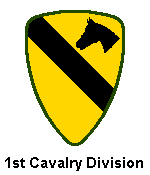



 If none of the data that you have found by surfing the reference unit chapter
titles and indexes measures up to your interests, you may want to deploy the
R&S (Reconnaissance and Surveillance) Scouts to search and identify keywords
or subjects within individual unit pages. Enter the descriptive keyword or
search terms(s) in the input field and "Click" on the Search button to screen the multiple DataBases of
the Cavalry OutPost and the garrisoned occupants - "The 1st Cavalry Division
and its Subordinate Units".
If none of the data that you have found by surfing the reference unit chapter
titles and indexes measures up to your interests, you may want to deploy the
R&S (Reconnaissance and Surveillance) Scouts to search and identify keywords
or subjects within individual unit pages. Enter the descriptive keyword or
search terms(s) in the input field and "Click" on the Search button to screen the multiple DataBases of
the Cavalry OutPost and the garrisoned occupants - "The 1st Cavalry Division
and its Subordinate Units".
 The search action will open the "first-team.us WebSite - R&S Scout Report",
which displays a listing of WebSite Titles and HTML Summaries that contain the
specific search term(s) of interest. To review any that best depicts a match
of your search term(s), "Click" on the WebSite Title to open a New Window.
After the WebSite is fully loaded, use the browser [EDIT/Find] Tool Button to
locate the search term within the page. After reviewing, close the New Window
to return to the listing of WebSites.
The search action will open the "first-team.us WebSite - R&S Scout Report",
which displays a listing of WebSite Titles and HTML Summaries that contain the
specific search term(s) of interest. To review any that best depicts a match
of your search term(s), "Click" on the WebSite Title to open a New Window.
After the WebSite is fully loaded, use the browser [EDIT/Find] Tool Button to
locate the search term within the page. After reviewing, close the New Window
to return to the listing of WebSites.
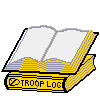



 If this is your first review of the Outpost of the 1st Cavalry Division and
its Subordinate Units, you may want to record your own report on your findings
during your visit, or perhaps you may want to review the log entries of other
visitors.
If this is your first review of the Outpost of the 1st Cavalry Division and
its Subordinate Units, you may want to record your own report on your findings
during your visit, or perhaps you may want to review the log entries of other
visitors.

To report on your findings,
"click" on the "Report-In"
Index Tab of the Troop Log. |
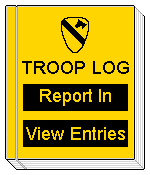
|

To review entries of others,
"Click"on the "View Entries"
Index Tab of the Troop Log. |
|---|

 As you journey through the history of the 1st Cavalry Division and its
assigned elements, you may find it interesting enough to send a message to
your friends and extend them an invitation for the opportunity to review the
rich history of the Division. We have made it easy for you to do. All that is
required is for you to click on the Push Button below, fill in their eMail
addresses and send.
As you journey through the history of the 1st Cavalry Division and its
assigned elements, you may find it interesting enough to send a message to
your friends and extend them an invitation for the opportunity to review the
rich history of the Division. We have made it easy for you to do. All that is
required is for you to click on the Push Button below, fill in their eMail
addresses and send.


|
The TITLE and URL of this WebSite are automatically read, formatted
and entered into your standard eMail form. |
|
|
Note - The eMail Message is processed and transmitted On-Line to the
addressee(s) via your Internet Provider.
Copyright © 2002, Cavalry Outpost Publications ® |




 eMail Your WebSite Comments.
eMail Your WebSite Comments.


 Return to "MyOwnPages"©.
Return to "MyOwnPages"©.

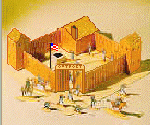 Copyright © 1996, Cavalry Outpost Publications ® and
Trooper Wm. H. Boudreau, "F" Troop, 8th Cavalry Regiment (1946 - 1947). All
rights to this body of work are reserved and are not in the public domain, or
as noted in the bibliography. Reproduction, or transfer by electronic means,
of the History of the 1st Cavalry Division, the subordinate units or any
internal element, is not permitted without prior authorization. Readers are
encouraged to link to any of the pages of this Web site, provided that proper
acknowledgment attributing to the source of the data is made. The information
or content of the material contained herein is subject to change without
notice.
Copyright © 1996, Cavalry Outpost Publications ® and
Trooper Wm. H. Boudreau, "F" Troop, 8th Cavalry Regiment (1946 - 1947). All
rights to this body of work are reserved and are not in the public domain, or
as noted in the bibliography. Reproduction, or transfer by electronic means,
of the History of the 1st Cavalry Division, the subordinate units or any
internal element, is not permitted without prior authorization. Readers are
encouraged to link to any of the pages of this Web site, provided that proper
acknowledgment attributing to the source of the data is made. The information
or content of the material contained herein is subject to change without
notice.
Revised 04 Apr '12 SpellChecked






 Introduction
Introduction















 Copyright © 1996, Cavalry Outpost Publications ® and
Trooper Wm. H. Boudreau, "F" Troop, 8th Cavalry Regiment (1946 - 1947). All
rights to this body of work are reserved and are not in the public domain, or
as noted in the bibliography. Reproduction, or transfer by electronic means,
of the History of the 1st Cavalry Division, the subordinate units or any
internal element, is not permitted without prior authorization. Readers are
encouraged to link to any of the pages of this Web site, provided that proper
acknowledgment attributing to the source of the data is made. The information
or content of the material contained herein is subject to change without
notice.
Copyright © 1996, Cavalry Outpost Publications ® and
Trooper Wm. H. Boudreau, "F" Troop, 8th Cavalry Regiment (1946 - 1947). All
rights to this body of work are reserved and are not in the public domain, or
as noted in the bibliography. Reproduction, or transfer by electronic means,
of the History of the 1st Cavalry Division, the subordinate units or any
internal element, is not permitted without prior authorization. Readers are
encouraged to link to any of the pages of this Web site, provided that proper
acknowledgment attributing to the source of the data is made. The information
or content of the material contained herein is subject to change without
notice.